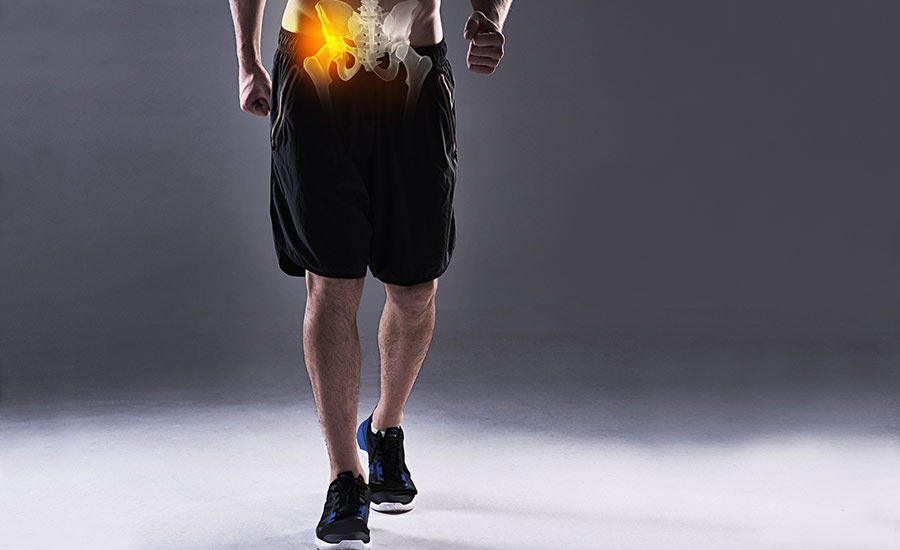
What Is Shoulder Replacement Surgery?

Meet Our Shoulder Replacement Specialists
Find a Specialist Near You
Get the care you deserve close to home at one of our New Jersey or New York Locations.
About Shoulder Replacement Surgery

Who Might Need Shoulder Replacement Surgery?
Shoulder replacement surgery may be recommended for individuals who are experiencing chronic pain and reduced range of motion in the shoulder joint.
The need for replacement surgery can be caused by a range of conditions, including:
- Osteoarthritis
- Rheumatoid arthritis
- Rotator cuff tear
- Avascular necrosis
- Shoulder fracture
Shoulder replacement surgery is a well-known procedure that offers many benefits such as pain relief, improved mobility, better quality of life and long-lasting results.
If you’re experiencing chronic shoulder pain, our specialists at OrthoEast may order imaging tests, such as X-rays, an MRI, or a CT scan, to get a better look at your shoulder joint and determine the extent of the damage. We’ll also walk through your medical history and conduct a physical examination before deciding on the next steps for your treatment.
Our shoulder replacement specialists at OrthoEast include Dr. Andrew McGinnis, Dr. Casey Pierce and Dr. John Callaghan.
In addition to shoulder replacement surgery, our physicians are also experts in fields such as knee replacement surgery, hip replacement surgery and various arthroscopy procedures.
Our board-certified physicians strive to provide a comfortable and confident experience throughout your procedure by guiding you every step of the way.
Conditions That Require Shoulder Replacement Surgery
There are several conditions that can require shoulder replacement surgery to relieve pain and restore mobility. These conditions include:
Osteoarthritis is a degenerative joint disease that can affect the shoulder joint, causing pain, stiffness, and limited mobility.
When other treatments such as medications, physical therapy, and corticosteroid injections aren’t effective, shoulder replacement surgery may be recommended to replace the damaged joint with an artificial joint.
In a recent study of patients who underwent shoulder replacement surgery, around 80% of shoulder damage was caused by osteoarthritis.
Rheumatoid arthritis is an autoimmune disease that can cause inflammation and damage to the joints — including the shoulder joint.
When other treatments such as medications and physical therapy are no longer effective, shoulder replacement surgery may be recommended to alleviate pain and improve mobility.
Rotator cuff tear arthropathy is a condition that occurs when a large rotator cuff tear leads to the development of arthritis in the shoulder joint.
This condition can cause severe pain and limited mobility and may require shoulder replacement surgery to alleviate symptoms.
Avascular necrosis is a condition that occurs when the blood supply to the bones in the shoulder joint is disrupted, causing the bone tissue to die.
This can lead to pain, stiffness, and limited mobility in the shoulder joint. Shoulder replacement surgery may be recommended to replace the damaged joint and restore function.
A severe fracture in the shoulder joint may require shoulder replacement surgery to replace the damaged joint and restore function.
This may be the case if the fracture and trauma prove to be severe and cannot be treated with other methods, such as casting or bracing.
How Is Shoulder Replacement Surgery Performed?
During shoulder replacement surgery, you are typically placed under general anesthesia.
We start by making an incision in your shoulder to expose the joint.
We then remove the damaged bone and cartilage, and your shoulder joint is replaced with an artificial implant. The implant may consist of a metal ball and socket or a plastic socket and metal ball.
Next, we attach the implant to the bone using screws or cement. After the implant is in place, we close your incision with sutures or staples.
Shoulder Replacement Procedures at OrthoEast
At OrthoEast, our fellowship-trained, board-certified physicians perform several types of shoulder replacement procedures, including:
In total shoulder replacement, both the ball and socket parts of the shoulder joint are replaced with artificial components.
We start by making an incision in the front of the shoulder to expose the damaged joint. We then remove the damaged bone and cartilage from the shoulder joint, including the head of the humerus bone and the socket in the shoulder blade.
We then reshape the socket part so you can receive the artificial implant, which consists of a socket component made of high-density polyethylene, and a metal ball component that is attached to a stem. The socket component is then secured in place with screws or cement.
Next, we reshape the humerus bone in the upper arm so you can receive the metal stem component of the implant. The stem component is inserted into the humerus bone and secured in place with cement, if necessary.
Finally, the artificial ball component is attached to the top of the metal stem, completing the replacement of the shoulder joint
This procedure is typically recommended for patients with severe arthritis or chronic rotator cuff tear.
In a partial shoulder replacement, also known as hemiarthroplasty, only the ball part of the shoulder joint is replaced with an artificial component.
During the surgery, we make an incision in the front of the shoulder to expose the damaged joint.
We then remove only the damaged part of the shoulder joint, which is typically the head of the humerus bone. The remaining part of the joint is left intact. Next, we prepare the remaining bone to receive the artificial implant, which is typically made of metal.
There are two approaches to partial shoulder replacement surgery:
- Stemmed hemiarthroplasty: In this procedure, we replace the head of the humerus with a metal ball, leaving the socket intact.If you suffer from arthritis that affects only the head of the humerus, with a healthy and unimpaired cartilage surface in the glenoid, this might be the right approach for you. Additionally, if your shoulder has extensively weakened bone in the glenoid or you suffer from badly torn rotator cuff tendons or arthritis, we might recommend this approach.
- Resurfacing hemiarthroplasty: In this procedure, we replace only the joint surface of the ball with a cap-like prosthesis — not the entire ball. We preserve bone while avoiding the risk of component wearing and loosening over time.If the cartilage surface on the glenoid is still intact, there has been no recent fracture of the humeral neck or head, and there is a preference to conserve the humeral bone, then resurfacing hemiarthroplasty might be the right approach for you.
In a reverse total shoulder replacement procedure, the positions of the ball and socket are switched, so that the metal ball is fixed to the socket and the plastic cup is connected to the humerus bone.
During reverse shoulder replacement surgery, we make an incision in either the top or front of the shoulder and remove the damaged bone before installing the prosthetics. This process usually takes around two hours to complete.
If you are experiencing intense shoulder pain due to a complete rotator cuff tear, a failed shoulder replacement or a complex fracture within the shoulder joint, we may recommend reverse shoulder replacement surgery to alleviate your condition.
This innovative approach has several benefits. One of the main benefits of a reverse shoulder replacement is that it shifts the joint’s center of rotation, which allows for the deltoid muscle, rather than the damaged rotator cuff, to move the arm.
Another benefit of the surgery is that it provides a more stable joint, which can reduce the risk of dislocation. This shift in mechanics will allow you to perform daily tasks such as lifting, reaching, and carrying.
There has been a significant rise in the number of shoulder arthroplasties performed in recent years, primarily due to the growth of RSA.
How To Prepare for Shoulder Replacement Surgery
Preparing for shoulder replacement surgery is an important step in ensuring a successful procedure and recovery. Here are some tips to help you prepare:
- Consult with OrthoEast: We will provide you with specific instructions on how to prepare for the procedure. This may include restrictions on eating or drinking before surgery and medications to avoid.
- Get in good physical shape: It’s important to be in good physical shape before surgery, as this can help with the recovery process. We may recommend physical therapy or other exercises to strengthen your shoulder and improve your overall health.
- Make necessary arrangements: After surgery, you may need help with everyday activities such as cooking, cleaning, and transportation. Make sure you have someone to assist you during the initial recovery period.
- Prepare your home: Before surgery, make sure your home is safe and accessible. This may include installing handrails, removing trip hazards, and ensuring that you have a comfortable and accessible place to rest and recover.
- Plan for post-operative care: After surgery, you will likely need physical therapy and follow-up appointments with your surgeon. We’ll make sure your post-op appointments are scheduled ahead of time, and that you have access to our team for support throughout your recovery.
How Long Does Shoulder Replacement Surgery Take?
In most cases, shoulder replacement surgery takes two to three hours to complete.
However, the length of the surgery can vary depending on several factors, such as the patient’s overall health, the extent of damage to the shoulder joint, and the type of replacement procedure being performed.
What To Expect After Shoulder Replacement Surgery
After shoulder replacement surgery, you can expect to experience some pain and discomfort, which can be managed with pain medication prescribed by your doctor. Swelling and bruising are also common and can last for several weeks after surgery.
You will likely need to wear a sling or immobilizer to keep your shoulder stable during the initial recovery period. During this time, it is important to avoid any activities that could put stress on the shoulder joint, including lifting heavy objects or reaching overhead.
Physical therapy is an important part of the recovery process and will usually begin within a few days or weeks after the surgery.
The goal of physical therapy is to improve range of motion, strength, and flexibility in your shoulder joint, and to help you return to normal activities as quickly and safely as possible.
Shoulder Replacement Surgery Recovery Time
Here is a general timeline of what to expect during your recovery from shoulder replacement surgery at OrthoEast:
- Immediately after the procedure: You will be taken to a recovery room at our OrthoEast facility to be monitored for several hours. You will be given pain medication as needed to manage discomfort, and your arm may be immobilized in a sling or brace to promote healing.
- First few days: You will be discharged from our orthopedic center, usually within one to three days. Pain and discomfort will continue and can be managed with prescribed pain medication. You may also experience swelling, bruising, and stiffness in the shoulder area. We’ll recommend a physical therapy plan to help you regain strength and mobility in your shoulder.
- First few weeks: Pain and discomfort will gradually decrease, and you will be able to rely less on pain medication. It’s important to continue with physical therapy to improve the range of motion and strength in your shoulder. You may need assistance with daily tasks, such as dressing and grooming. You will be able to gradually increase your activity level, but you should avoid heavy lifting or strenuous activity.
- First few months: You will continue with physical therapy to increase strength, range of motion, and function in your shoulder. You can continue to increase your activity level, but you should still avoid heavy lifting or strenuous activity. You will have follow-up appointments with our OrthoEast team to monitor your progress and ensure proper healing.
Schedule a Consultation With Our Shoulder Replacement Specialists At OrthoEast
Whether you require a partial shoulder replacement, total shoulder replacement, or you’re not sure what condition you’re in, but you know that you’re in pain, you’re in good hands with our compassionate and caring team at OrthoEast.
Book a consultation with our OrthoEast specialists at one of our orthopedic facilities in New Jersey or New York, to start your journey to a pain-free future.
Find us in:
- Wayne, NJ
- Morristown, NJ
- Clifton, NJ
- Linden, NJ
- Wall Township, NJ
- New York, NY










